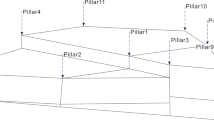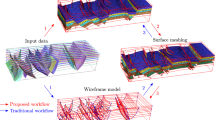Abstract
Under the context of subterranean formation modeling using finite volume methods, the computational domain is a basin, a reservoir, or an underground CO2 storage site. Such a domain has a layered structure and is geometrically described by its layer limits called horizons and random disruption of layers called faults. Horizons and faults are both numerically represented by 3D triangulated surface meshes. Respecting the interface formed by horizons and faults, the volume mesh of the subterranean formation is required to be mainly hexahedral, with a few tetrahedrons, prisms or pyramids allowed along the faults, where mesh non-conformity is tolerated. A “constrained grid” approach is proposed to generate the so-desired mesh. Firstly, each horizon surface is unfolded with fault traces being sewn. Then, for each unfolded horizon, a regular grid with the same topology is generated from its boundary. Subsequently, node relocation and conditional grid refinement are applied to constrain fault traces to the grid. Afterwards, each grid is mapped back to its corresponding 3D horizon surface with fault nodes being split. Finally, a hex-dominant mesh is generated by connecting consecutive grids along corresponding nodes, with some elements cut into two by faults and degenerated into prisms, tetrahedrons, and pyramids. An optimization procedure is then applied to enhance the shape quality of the resulting 3D mesh.





























Similar content being viewed by others
Notes
A software developed by IFP France.
A software developed by IFP France.
A software developed by IFP France.
A software from UTT France which realizes isometric surface unfolding by minimizing elastic deformation.
References
Hantschel T, Kauerauf AI (2009) Fundamentals of basin and petroleum systems modeling. Springer, Heidelberg
Heinemann ZE, Brand CW (1989) Gridding techniques in reservoir simulation. International Forum on Reservoir Simulation, Alpbach, pp 339–426
Li Y, Fuchs L (1996) An anisotropic local grid refinement method for fluid flow simulation. In: Numerical heat transfer. Part B: Fundamentals, vol 30, no. 2. Taylor & Francis, Philadelphia, pp 195–215
Gourley EN, Ertekin T (1997) Application of a local grid refinement technique to model impermeable barriers in reservoir simulation. In: Proceedings of the SPE eastern regional meeting, Lexington. doi:10.2118/39216-MS
Ponting DK (1989) Corner point geometry in reservoir simulation. In: Proceedings of the ECMOR 1, Cambridge, pp 45–65
Heinemann ZE, Heinemann GF, Tranta BM (1998) Modelling heavily faulted reservoirs. In: Proceedings of the SPE annual technical conferences, pp 9–19
Pedrosa OA, Aziz K (1985) Use of hybrid grid in reservoir simulation. In: Proceedings of the SPE Middle East oil technical conference, Bahrain, pp 99–112
Flandrin N, Borouchaki H, Bennis C (2006) 3D hybrid mesh generation for reservoir simulation. IJNME 65(10):1639–1672
George PL (1991) Génération automatique de maillages. Masson, Paris
Frey PJ, George PL (1999) Maillages applications aux éléments finis. Hermes Science Publications, Paris
Marechal L (2001) A new approach to octree-based hexahedral meshing. In: Proceedings of the 10th international meshing roundtable, pp 209–221
Tchon K-F, Khachan M, Guibault F, Camarero R (2003) Constructing anisotropic geometric metrics using octrees and skeletons. In: Proceedings of the 12th international meshing roundtable, pp 293–304
Owen SJ, Saigal S (1999) H-Morph: an indirect approach to advancing front hex meshing. In: Proceedings of the 2nd symposium on trends in unstructured mesh generation
Staten ML, Owen SJ, Blacker TD (2005) Unconstrained paving & plastering: a new idea for all hexahedral mesh generation. In: Proceedings of the 14th international meshing roundtable, Springer, San Diego, pp 399–416
Armstrong C, Robinson D, McKeag R, Li T, Bridgett S, Donaghy R, McGleenan C (1995) Medials for meshing and more. In: Proceedings of the fifth international meshing roundtable, pp 277–288
Guoy D, Erickson J (2004) Automatic blocking scheme for structured meshing in 2D multiphase flow simulation. In: Proceedings of the 13th international meshing roundtable, pp 121–132
Lai M, Benzley S, White D (2000) Automated hexahedral mesh generation by generalized multiple source to multiple target sweeping. Int J Numer Methods Eng (John Wiley) 49(1):261–275
Roca X, Sarrate J (2006) An automatic and general least-squares projection procedure for sweep meshing. In: Proceedings of the 15th international meshing roundtable, Springer, Berlin, pp 309–324
Coons SA (1967) Surfaces for computer-aided design of space forms. MIT CSAIL Publications, Cambridge
Author information
Authors and Affiliations
Corresponding author
Rights and permissions
About this article
Cite this article
Ran, L., Borouchaki, H., Benali, A. et al. Hex-dominant mesh generation for subterranean formation modeling. Engineering with Computers 28, 255–268 (2012). https://doi.org/10.1007/s00366-011-0234-x
Received:
Accepted:
Published:
Issue Date:
DOI: https://doi.org/10.1007/s00366-011-0234-x




